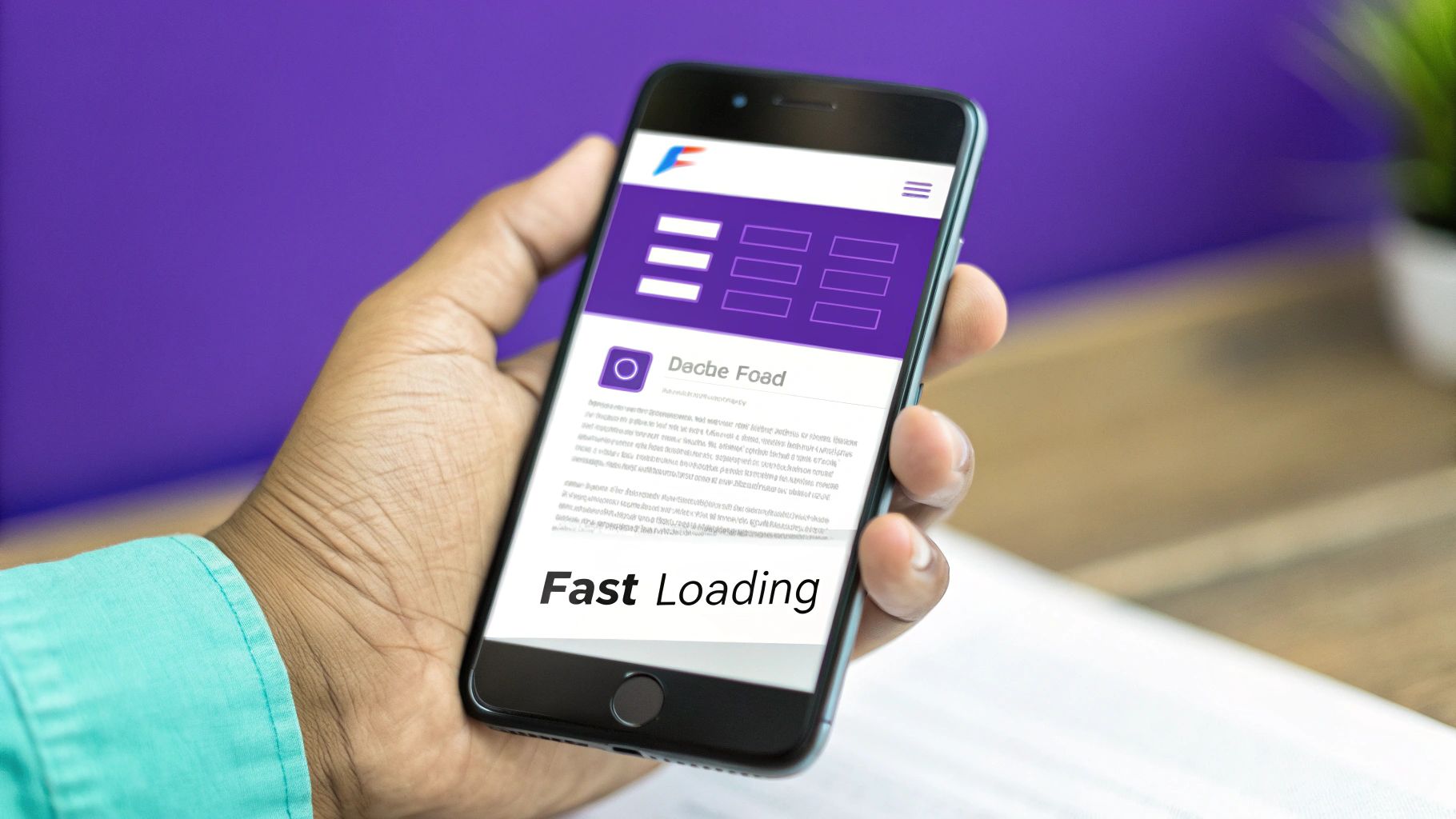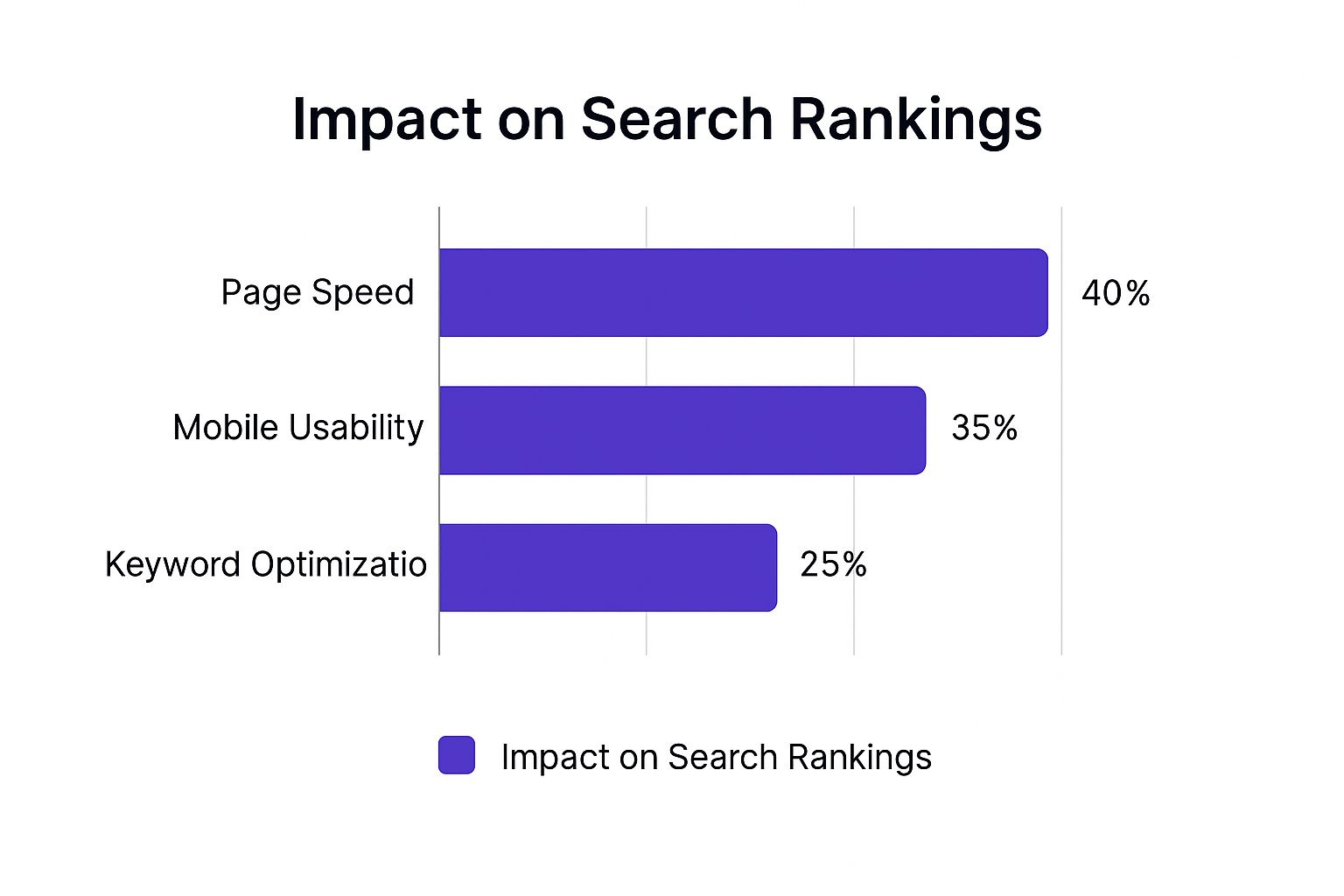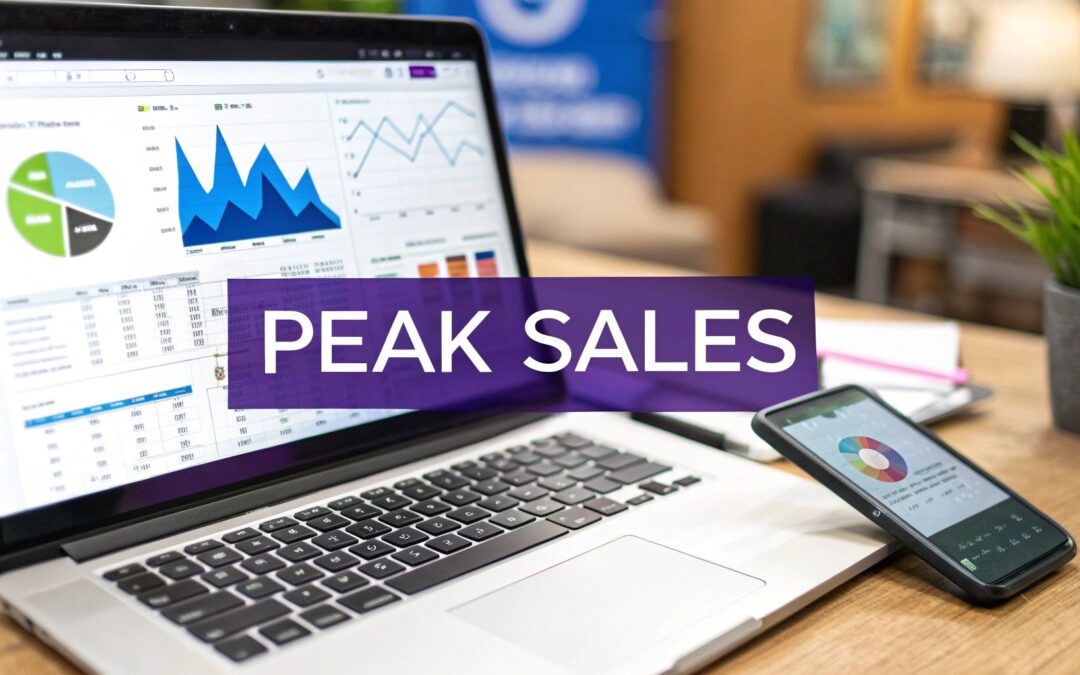If you want to build an e-commerce store that doesn't just exist but thrives, you need to think beyond just having products for sale. It's about creating a high-performance sales machine, and that machine has four critical, interconnected parts: blazing-fast site speed, smart SEO, a seamless user experience (UX), and rock-solid conversion rate optimization.
Get any one of these right, and you'll see a lift. Get all four working in harmony? That’s when the magic happens.
Your Essential Ecommerce Optimization Framework

This guide is your hands-on roadmap for turning your WooCommerce and Divi store into a powerhouse. Forget the high-level theory. We're diving deep into the practical, actionable steps that drive real revenue growth.
A slow, confusing, or hard-to-find website is a leaky bucket, losing you sales every single day. The competition out there is no joke. By 2025, the web will be home to roughly 28 million e-commerce sites, with over 2,162 new ones popping up daily. Yet, despite that massive number, the average global e-commerce conversion rate is a tiny 2.5% to 3%. You can dig into more of these e-commerce stats to see just how fierce the landscape is.
The data screams one thing loud and clear: just being online isn't enough. You have to be better.
The Four Pillars of Success
To break through the noise, you need a structured approach. I like to think of optimization as a system built on four foundational pillars. Each one supports the others, creating a powerful flywheel where an improvement in one area gives a serious boost to all the others.
Before we dive into the nitty-gritty of each area, let's get a high-level view of how they all fit together. Think of this as the strategic blueprint for everything we're about to cover.
The Four Pillars of Ecommerce Optimization
| Pillar | Primary Goal | Key Metrics | Impact on Revenue |
|---|---|---|---|
| Site Speed | Deliver an instant, professional experience that reduces bounce rates. | Page Load Time, Core Web Vitals (LCP, FID, CLS), TTFB | A 1-second delay can cut conversions by 7%. Faster sites sell more, period. |
| Strategic SEO | Attract high-intent, qualified traffic from search engines. | Organic Traffic, Keyword Rankings, Click-Through Rate (CTR) | Drives "free" traffic from customers actively searching for your products. |
| Frictionless UX | Make the customer's journey from discovery to checkout effortless and intuitive. | Bounce Rate, Time on Site, Pages per Session, Cart Abandonment Rate | A great UX builds trust and makes it easy for people to give you their money. |
| Conversion Rate | Persuade more visitors to take the desired action (i.e., make a purchase). | Conversion Rate, Add to Cart Rate, Average Order Value (AOV) | Directly increases the value of every visitor you bring to your site. |
Each pillar is a specialty in its own right, but their true power is unlocked when you treat them as a single, cohesive strategy.
A huge mistake I see all the time is a store owner going all-in on SEO while completely ignoring site speed. They'll spend months getting to the #1 spot on Google, only to have a 10-second page load time. All that hard work is wasted when visitors click back to the search results before the page even loads.
This guide will break down each of these pillars into practical, step-by-step actions you can take right now. We'll look at how to audit where you stand today and how to make specific, impactful changes using my go-to plugins and real-world examples. By understanding how these four elements connect, you can build a comprehensive strategy to not just optimize your website, but to create a sustainable engine for growth.
Achieving Peak Site Speed for WooCommerce and Divi
Site speed isn't just some techy metric to obsess over; it’s the very first impression your ecommerce site makes on a potential customer. A slow, clunky site doesn't just annoy visitors—it actively sends them packing, taking a direct hit on your sales and search engine rankings.
Let's move past the generic advice and really get our hands dirty. We're going to optimize your ecommerce website for blistering performance, focusing on that powerful but sometimes heavy combination of WooCommerce and Divi.
The financial incentive alone is staggering. Slow website loading times are estimated to cost online retailers over $2 billion annually in lost sales. That makes speed optimization less of a chore and more of a critical investment. And as we look to the future, optimization is only getting more complex, with 19% of SEO pros planning to integrate generative AI into their workflows by 2025. It just shows how vital it is to stay ahead of the curve. You can read more about evolving ecommerce marketing strategies here.
Start with a Solid Foundation: Your Hosting and CDN
Before you even think about touching a plugin, know this: your site's speed potential is defined by its hosting. Shared hosting might be cheap, but for an ecommerce store, it's like trying to win a marathon in flip-flops. You simply need a performance-focused host for a serious WooCommerce setup.
Managed WordPress hosts like Kinsta or application-focused platforms like Cloudways offer server environments built and tuned specifically for WordPress. They come with features like server-level caching, which blows any plugin-based solution out of the water. This isn't an upsell; it's a fundamental requirement for a fast online store.
Next up, a Content Delivery Network (CDN) is completely non-negotiable. A CDN grabs your static assets—images, CSS, and JavaScript files—and spreads them across a global network of servers. So, when a customer from London visits your site hosted in Texas, the CDN delivers those files from a server in Europe, dramatically slashing load times. Cloudflare is a fantastic and easy-to-use option, and many premium hosts even bundle a CDN with their plans.
I once worked with a client whose product page took a painful eight seconds to load. They had already optimized their images and installed a caching plugin, but they were stuck on a $5/month shared hosting plan. After we migrated them to a proper managed host, their load time dropped to under three seconds before we even touched a single optimization plugin. That’s the power of a solid foundation.
Taming Divi and Its Resources
Divi is an incredible visual builder, but all that flexibility can come at a performance price if you’re not careful. Out of the box, it loads a fair amount of CSS and JavaScript to power all its potential modules and features. The secret is to trim the fat.
Luckily, Divi has some powerful built-in performance tools that can make a massive difference.
- Dynamic CSS: This brilliant feature only generates and loads the CSS required for the modules you're actually using on any given page. No more loading code for elements that aren't even there.
- Dynamic JavaScript Libraries: This works in a similar way, deferring the loading of JavaScript for certain modules (like the Video Slider) until a visitor actually needs them.
- Critical CSS: This is a real game-changer. It identifies the CSS needed to render the "above-the-fold" content—what a user sees immediately—and loads it instantly. The rest of the CSS is deferred, making the page feel lightning-fast to the user.
We go into much more detail on these settings in our dedicated guide on how to speed up your Divi website, which offers a deep dive into these essential configurations.
The Right Plugins and Proper Configuration
With your foundation sorted, it's time to add a few carefully chosen performance plugins. The goal isn’t to install more plugins, but to install the right ones and configure them perfectly.
1. Caching with WP Rocket: This is my absolute go-to premium caching plugin. Sure, it handles page caching, but its true magic lies in file optimization. You can use it to minify and combine your CSS and JavaScript files, which reduces the number of requests a browser needs to make. Crucially, its "Delay JavaScript Execution" feature can postpone loading non-essential scripts (like chat widgets or tracking pixels) until a user actually interacts with the page.
2. Image Optimization with ShortPixel: On ecommerce sites, large, unoptimized images are one of the most common speed killers. ShortPixel is a lifesaver. It automatically compresses any new images you upload and can bulk-optimize your entire existing media library. It also creates WebP versions of your images—a modern format with superior compression—and serves them to compatible browsers automatically.
Of course, general best practices are just the start. If you want to dig deeper, exploring platform-specific resources can uncover tailored insights. You can find tons of great WooCommerce optimization strategies that build upon these core principles.
By combining server-level power, smart theme configuration, and targeted plugin use, you can transform a sluggish store into one that feels instantly responsive and truly professional.
Driving High-Intent Traffic with Ecommerce SEO

A lightning-fast website is a great start, but those speedy pages won't make you a dime if nobody can find them. Driving high-intent traffic is the fuel for any e-commerce engine, and a smart SEO strategy is how you fill the tank. It’s all about getting the right people—the ones actively searching for what you sell—to your digital doorstep.
Here’s a tough pill to swallow: less than 10% of all websites get any organic traffic from Google. That means a staggering 90% are essentially invisible in search results. To break through that noise, you need an SEO plan built specifically for the unique structure of an online store.
This goes way beyond just sprinkling keywords on a page. It’s a blend of getting the technical details right and writing compelling copy that speaks directly to a buyer's problems and desires.
Laying the Technical SEO Groundwork
Before we even think about keywords, we have to make sure search engines can properly crawl, understand, and index your store. This technical foundation is what makes all your other on-page efforts actually work. For a WooCommerce site, this means dialing in a few key areas.
First up, your URL structures. They need to be clean and descriptive. A generic URL like yourstore.com/p?id=123 tells Google and your customers absolutely nothing. In contrast, yourstore.com/boots/womens-leather-hiking-boots is instantly understandable and gives you a nice little keyword boost.
Next, implementing structured data, or Schema markup, is one of the biggest technical SEO wins you can get. It's a bit of code that helps Google understand the context of your content, which leads to those eye-catching "rich snippets" in search results. For an e-commerce site, these are non-negotiable:
- Product Schema: Details the product name, brand, description, and images.
- Offer Schema: Specifies the price, currency, availability, and any sale conditions.
- Review Schema: Displays your aggregate star rating and the total number of reviews.
When these work together, your search listings can pop with pricing, "in stock" labels, and star ratings, which dramatically increases your click-through rate. Thankfully, plugins like Rank Math or Yoast SEO make adding this schema to WooCommerce product pages incredibly simple.
To see how all these technical pieces fit into a bigger picture, you can dig into the different stages of a successful ecommerce Divi SEO strategy.
Uncovering Buyer Intent with Long-Tail Keywords
Now for the fun part: finding the exact phrases your ideal customers are typing into Google. It's tempting to go after a massive term like "hiking boots," but the competition is insane and the searcher's intent is a total mystery. Are they just browsing? Doing research for a school project? Looking for pictures?
The real money is in long-tail keywords. These are longer, more specific search queries that signal someone is much further along in their buying journey.
Think about the mindset difference between a search for "hiking boots" versus "waterproof leather hiking boots for wide feet." That second person knows exactly what they want and is probably ready to pull out their credit card.
My strategy always revolves around these high-intent phrases. Sure, they have lower search volume, but the traffic they bring in is so much more valuable because it's highly qualified. The goal isn't to get the most traffic; it's to get the most relevant traffic.
Tools like Ahrefs or Semrush are my go-to for this. You can plug in a broad "seed" keyword and use their research tools to unearth thousands of longer, question-based, or hyper-specific variations that real people are searching for.

This data is an absolute goldmine for creating content that answers specific customer questions and solves their problems.
Weaving Keywords into Your Content Naturally
Once you have your list of valuable long-tail keywords, the final piece is to integrate them into your site's content. The key here is to do it naturally. It has to help the user first and the search engine second.
Here’s where you should focus your efforts:
Product Titles and Descriptions: This is your prime real estate. Instead of a bland title like "Hiker Pro Boots," go for something more descriptive like "Hiker Pro – Men's Waterproof Leather Hiking Boots." In the description, focus on the benefits and features that directly address what the user was searching for.
Category Pages: These pages are perfect for targeting those mid-length keywords (e.g., "men's hiking boots"). Optimize the category title, but also add a short, helpful paragraph at the top of the page that uses your target keyword and helps guide shoppers.
Blog Content: Your blog is the perfect place to answer the questions your long-tail keyword research uncovered. A post titled "How to Choose the Best Hiking Boots for Wide Feet" can attract incredibly qualified traffic. It builds trust and positions you as an expert before you even ask for the sale.
By combining a rock-solid technical SEO foundation with a smart, long-tail keyword strategy, you can create a system that consistently attracts shoppers who aren't just looking—they're ready to buy. This is how you optimize an e-commerce website for sustainable, profitable growth.
Designing a Frictionless Mobile and User Experience

A visitor who is confused, frustrated, or lost will never become a customer. It's as simple as that. After getting your site's speed and SEO in order, your next mission is to optimize your ecommerce website for a truly frictionless user experience (UX). Every click, scroll, and interaction has to feel intuitive, guiding users toward making a purchase without them even realizing it.
Friction is anything that creates hesitation or makes things difficult. Think of a hard-to-find 'Add to Cart' button, a confusing navigation menu, or a checkout process that feels like an interrogation. Hunting down and eliminating these roadblocks is essential, especially on mobile, where patience wears thin in seconds.
The data tells a story we can't ignore. While mobile devices drive 41% of all ecommerce traffic, they also have the highest cart abandonment rates. In fact, globally, a staggering 70% of potential purchases are left behind in the cart. This drags the average conversion rate down to a mere 1.81%. These numbers scream urgency. We have to perfect the mobile journey and radically simplify the checkout. You can explore more ecommerce visitor statistics to see just how big this opportunity is.
Anatomy of a High-Converting Product Page
Your product page is where the sale is won or lost. It’s not just a listing; it’s your digital salesperson, and every element needs to work together to build desire, answer questions, and make buying the obvious next step.
Here's what I focus on:
- High-Quality Visuals: Show, don't just tell. Use multiple high-resolution images that showcase the product from every conceivable angle. Even better? Add a short video of the product in action. A solid 67% of consumers say image quality is "very important" to their decision.
- A Clear Call-to-Action (CTA): Your 'Add to Cart' button needs to be impossible to miss. Use a bold, contrasting color that pops off the page, and keep the text direct and compelling.
- Benefit-Driven Descriptions: Don't just list features. Explain how those features solve a problem or make the customer's life better. Break up text with short, scannable paragraphs and bullet points so it’s easy to digest.
I’ve seen stores boost conversions by over 10% just by changing their CTA button from a muted gray to a vibrant orange. It sounds almost too simple, but consciously guiding the user's eye to the most important action on the page is a cornerstone of great UX.
Intuitive Navigation and Smart Filtering
If people can't find what they're looking for almost instantly, they're gone. Your site's navigation is their map. For Divi users with big product catalogs, setting up a clear Mega Menu with a tool like Divi Areas Pro can be a total game-changer. It lets you lay out categories, sub-categories, and even featured products in a clean, organized way.
Beyond the main menu, smart product filters are non-negotiable. Let people drill down and refine their search by:
- Price range
- Size or color
- Brand
- Customer rating
This simple feature turns a potentially overwhelming browsing session into a focused, efficient hunt for the perfect product.
Mastering the Mobile Experience
A thumb-friendly interface is no longer a "nice-to-have." When designing for mobile, you have to think about the physical reality of how someone holds and uses their phone.
Key Mobile UX Considerations:
- Reachable CTAs: Place key buttons like 'Add to Cart' and 'Checkout' in the "thumb zone"—that easy-to-reach area at the bottom of the screen. No one wants to perform finger gymnastics just to buy from you.
- Simplified Forms: Long, complex forms are absolute conversion killers on mobile. Strip them down to the bare essentials. Use features like address auto-complete and always offer a guest checkout option to minimize friction.
- Legible Text and Spacing: Make sure your font size is large enough to be read comfortably on a small screen. Just as important, give your buttons and links enough breathing room to prevent frustrating fat-finger taps.
Building Trust to Guide the Purchase
At the end of the day, a frictionless experience is built on trust. Shoppers are naturally cautious online, and it's your job to put their minds at ease. You can build this confidence by strategically placing trust signals throughout your site.
These signals are your credibility boosters:
- Social Proof: Display customer reviews and star ratings where people can see them.
- Security Badges: Show SSL and payment processor badges (like Visa, PayPal, etc.) during checkout.
- Clear Policies: Make your return policy and shipping information dead simple to find.
By meticulously analyzing and improving each of these areas—from product page design to mobile checkout—you systematically remove the psychological barriers that stop visitors from becoming loyal customers.
Turning Clicks into Customers with Smart CRO
Getting traffic to your site is a huge win, but it’s only half the battle. The ultimate goal is to turn those visitors into paying customers, and that’s where Conversion Rate Optimization (CRO) comes in. It's the art and science of persuading more people to take the action you want—in this case, making a purchase.
This isn’t about guesswork or blindly changing button colors. Smart CRO is a data-driven process. It’s about forming a hypothesis based on user behavior, testing it methodically, and letting your customers show you what actually works. This is how you transform all that hard-earned traffic into measurable profit.
Setting Up Meaningful A/B Tests
The core of any solid CRO strategy is A/B testing, also known as split testing. The concept is simple: you create two versions of a page element (Version A, the control, and Version B, the variation) and show them to different segments of your audience to see which one performs better.
Tools like Google Optimize (while it's being sunset, its principles are timeless) or premium options like VWO make this process surprisingly straightforward. They handle the technical side of splitting traffic and tracking conversions, which frees you up to focus on the creative part: what to test.
For an e-commerce store, some of the highest-impact tests you can run involve:
- Headlines: Test a benefit-driven headline against a feature-focused one. For example, "Stay Warm All Winter" vs. "800-Fill Down Insulation." Which one resonates more with your buyers?
- Call-to-Action (CTA) Buttons: Experiment with color, size, and text. Does "Buy Now" create more urgency than "Add to Cart"? Does a vibrant orange button get more clicks than a muted blue one? You’d be surprised.
- Product Page Layouts: Try moving your customer reviews higher up the page or testing a layout with product videos placed more prominently.
The key is to change only one element at a time. If you change both the headline and the CTA button, you’ll never know which change was responsible for the lift in conversions.
We often see clients eager to test everything at once, but the real insights come from isolated, disciplined tests. To get you started, here are a few ideas that consistently deliver results, categorized by their potential impact and how much work they take to set up.
High-Impact CRO Tests for Ecommerce Sites
| Test Idea | Element to Test | Potential Impact | Implementation Effort |
|---|---|---|---|
| Urgency-Driven CTA | Button Text & Microcopy | High | Low |
| Trust Badge Placement | Below "Add to Cart" vs. in Footer | Medium | Low |
| Guest Checkout vs. Account Creation | Checkout Flow | High | Medium |
| Product Video vs. Static Image | Primary Product Media | High | High |
| Benefit-Oriented Headlines | Product Page H1 | Medium | Low |
| Exit-Intent Discount Popup | Popup Offer & Design | High | Medium |
These tests are a great starting point because they target key decision-making moments in the buyer's journey. Even a small win can have a significant ripple effect on your bottom line.
Proven Strategies to Reduce Cart Abandonment
Cart abandonment is the silent killer of e-commerce revenue. A customer adds an item to their cart, goes all the way to checkout, and then vanishes. To optimize your ecommerce website effectively, you have to plug this leak.
One of the most powerful tools in your arsenal is an exit-intent popup. This technology detects when a user’s cursor is about to leave your site and presents them with a last-chance offer, like a 10% discount or free shipping. It's a low-friction way to capture a sale you were about to lose. For Divi users, you can find a great walkthrough on how to increase ecommerce sales with popups using targeted triggers.
Another critical strategy is offering a guest checkout option. Forcing users to create an account is a major point of friction. A study found that 24% of shoppers abandoned a cart just because the site wanted them to create an account. Let them buy first and create an account later. It’s that simple.
In my experience, a simple three-part automated cart recovery email sequence can recover between 5% and 15% of abandoned carts. The first email is a gentle reminder, the second might introduce a sense of urgency, and the third could offer a small incentive. It's an automated system that brings in sales while you sleep.
This infographic breaks down where to focus your broader optimization efforts for maximum impact on rankings, which directly influences the quality of traffic you get in the first place.

As the chart highlights, while technical SEO is the foundation, user-centric metrics like page speed and mobile experience have an even greater influence on your site's overall success.
Small Changes That Drive Big Revenue
You don't always need a complete site overhaul to see results. Sometimes, small, strategic tweaks can lead to significant gains.
I once worked with a client selling high-end kitchen knives. Their product descriptions were very technical, listing the steel type and blade angle. We rewrote the descriptions to focus on benefits: "Effortless slicing through ripe tomatoes" and "A perfectly balanced handle that feels like an extension of your hand." This simple change in copy, which took less than an hour, resulted in a 12% increase in conversions for that product line.
Another highly effective tactic is adding a "Frequently Bought Together" or "Complete the Look" section on your product and cart pages. This not only increases the Average Order Value (AOV) but also improves the customer experience by making genuinely helpful recommendations. It’s a classic upselling technique that works because it provides real value, not just a sales pitch.
Your Top Ecommerce Optimization Questions, Answered
When you start digging into optimizing an e-commerce site, the big picture makes sense, but the practical questions quickly pile up. "How often do I need to do this?" or "Which plugins are actually necessary?" It's easy to get stuck on the details.
Let's clear those up so you can get back to making meaningful improvements with confidence.
How Often Should I Audit My Website?
A complete, top-to-bottom technical and SEO audit is something you should pencil in at least once a year. This is your big-picture check-up to find major issues like index bloat, widespread broken links, or significant drops in keyword rankings.
But optimization isn't a "set it and forget it" task. It’s an ongoing process.
- Monthly: Keep a close eye on your site speed and Core Web Vitals. These metrics can change unexpectedly, and catching a slowdown early is crucial before it starts eating into your sales.
- Quarterly: Dive into user behavior with tools like heatmaps and session recordings. This helps you find new friction points in the customer journey as your site and audience evolve.
- Always-On: Conversion rate optimization never really stops. I recommend aiming to launch at least one new A/B test every quarter based on what your data is telling you.
Think of it like maintaining a performance car. It needs regular tune-ups to stay in top shape, not just a single overhaul when it breaks down.
What Are the Most Critical Plugins for a Divi & WooCommerce Site?
With a Divi and WooCommerce build, it’s not about piling on more plugins—it’s about choosing the right ones. The goal is to add powerful functionality without slowing everything down.
My go-to stack for almost any e-commerce project includes:
- WP Rocket: For site speed, a premium caching plugin is non-negotiable. It simply handles page caching, file minification, and lazy loading far better and more easily than any free alternative I've tried.
- ShortPixel or Imagify: Images are almost always the heaviest assets on an e-commerce page. An automatic image optimization plugin is essential to shrink file sizes without making your product photos look blurry.
- Rank Math or Yoast SEO: These are the undisputed industry leaders for a reason. They manage all your on-page SEO, generate sitemaps, and, most importantly, handle the critical Schema markup for your products.
- Divi Areas Pro: For serious CRO, you need an advanced popup and dynamic content tool. This is what lets you build effective exit-intent offers, top-bar announcements, or slide-in promotions to capture abandoning visitors and guide users.
Can I Really Optimize My Website Myself?
Absolutely. A motivated store owner can tackle many of the foundational tasks. Following a solid guide, you can definitely install and configure the right plugins, compress your images, and rewrite your product descriptions for better SEO. Those actions alone can deliver a huge win.
The key is knowing when to call in a specialist.
When you get into advanced technical SEO, custom code tweaks for speed, or designing a complex A/B testing strategy, bringing in an expert can provide a massive return on investment.
A smart approach is to handle the fundamentals yourself and then bring in an expert to tackle the more complex challenges. This empowers you to manage your site effectively while ensuring you're not leaving significant revenue on the table.
What Is a Realistic Conversion Rate to Aim For?
It's tempting to look at the global average, which hovers around 2.5-3%, and use that as your benchmark. But honestly, chasing a generic average is usually a waste of time. That number gets skewed by countless factors like industry, product price, and traffic source.
Your most important benchmark is your own historical performance.
Instead of obsessing over a generic number, a much more powerful goal is to aim for consistent, incremental growth. For example, focus on increasing your current conversion rate by 10-20% over the next quarter through targeted tweaks. High-ticket items will naturally have lower conversion rates than cheap impulse buys. The only number that matters is yours.
Ready to build the advanced popups, slide-ins, and mega menus that drive conversions? Divimode gives you the tools to put these strategies into action. Check out Divi Areas Pro and start building a more interactive, higher-performing website today.






